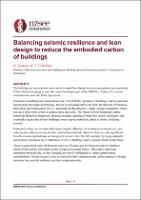| dc.description.abstract | The building and construction sector needs to make big changes to reduce greenhouse gas emissions if New Zealand is going to meet the legally binding targets of the 2019 Zero Carbon Act, and its commitments under the Paris Agreement.
Emissions in building and construction come from both the operation of buildings, and the materials and products that make up buildings, known as embodied carbon. In 2020, the Ministry of Business, Innovation and Employment (MBIE) launched the Building for Climate Change programme, which sets out a bold vision of how to reduce these emissions. The Whole-of-Life Embodied Carbon Emissions Reduction framework proposes to make reporting of embodied carbon mandatory, and eventually require that all new buildings meet a cap on embodied carbon to obtain a building consent.
Embodied carbon can be reduced by improving the efficiency of construction material use, and reducing the carbon intensity of those construction materials. However there are also significant benefits in ensuring buildings are designed to achieve their full life potential: by being adaptable and resilient, emissions are avoided from extensive building repairs, and new builds in the future.
There is a perceived trade-off between material efficiency and resilience in order to minimise whole-of life carbon, particularly in the design of structural frames. These have significant embodied emissions and, in New Zealand, are heavily influenced by seismic performance considerations. Further research work is required to draw attention to the carbon impacts of design decisions that consider resilience and lean design principles. | |

